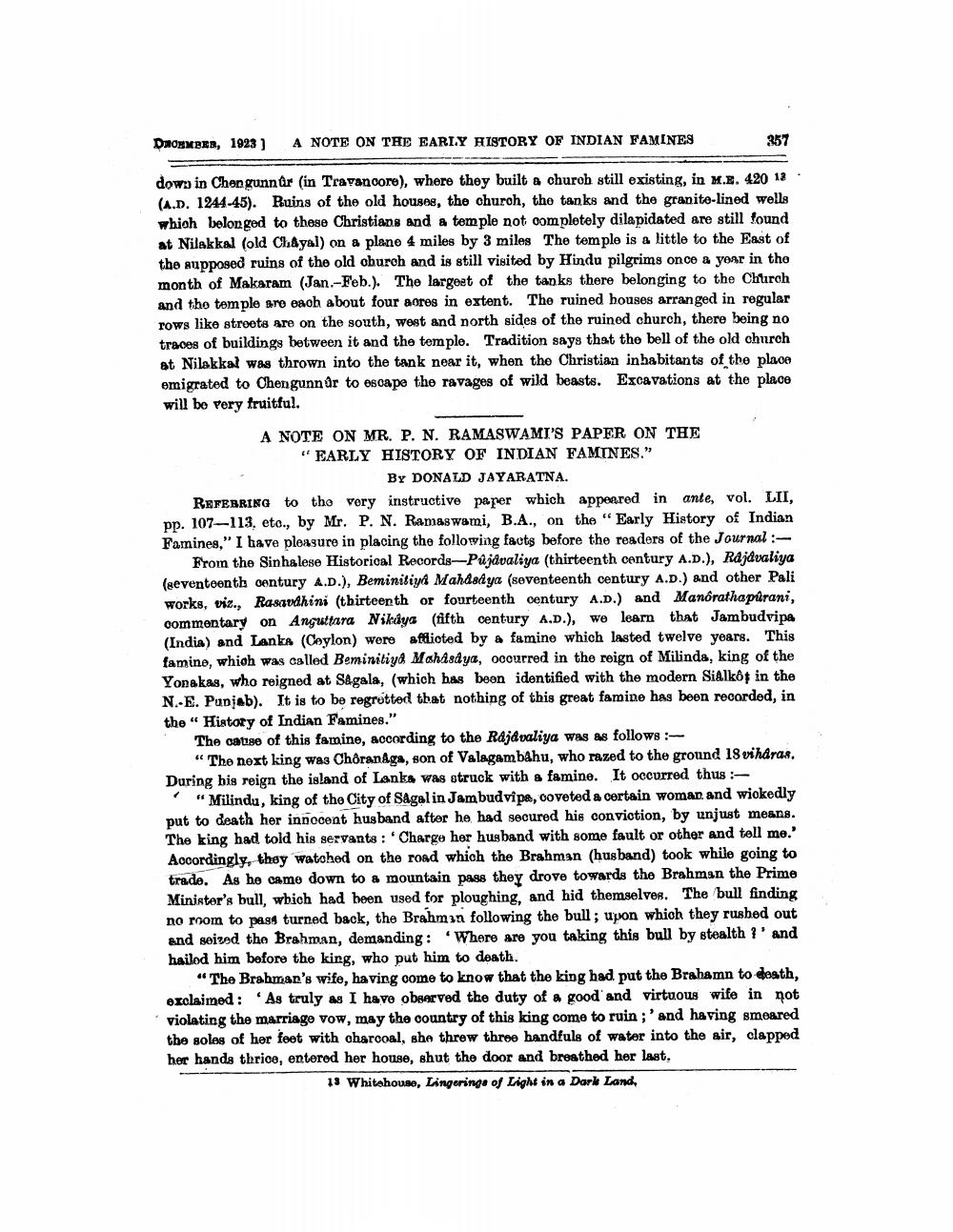________________
DNOWMBER, 1023)
A NOTE ON THE EARLY HISTORY OF INDIAN FAMINES
357
dowo in Chengunnar (in Travancore), where they built a church still existing, in M.e. 420 18. (A.D. 1244-45). Ruins of the old houses, the church, the tanks and the granito-lined wells whioh belonged to these Christians and a temple not oompletely dilapidated are still found at Nilakkal (old Chayal) on a plane 4 miles by 3 miles The temple is a little to the East of the supposed ruins of the old oburch and is still visited by Hindu pilgrims once a year in the month of Makaram (Jan-Feb.). The largest of the tanks there belonging to the Church and the temple are each about four acres in extent. The ruined houses arranged in regular rows like stroots are on the south, west and north sides of the ruined church, there being no traces of buildings between it and the temple. Tradition says that the bell of the old church at Nilakkal was thrown into the tank near it, when the Christian inhabitants of the place emigrated to Chengunn úr to escape the ravages of wild beasts. Excavations at the place will be very fruitful.
A NOTE ON MR. P. N. RAMASWAMI'S PAPER ON THE "EARLY HISTORY OF INDIAN FAMINES."
BY DONALD JAYARATNA. REFERRING to the very instructive paper which appeared in ante, vol. LII, pp. 107-113, eto., by Mr. P. N. Ramaswami, B.A., on the "Early History of Indian Famines," I have pleasure in placing the following facts before the readers of the Journal :
From the Sinhalese Historical Records-Půjdvaliya (thirteenth oentury A.D.), Rajavaliya (seventeenth century A.D.), Beminiliyi Mahasiya (seventeenth century A.D.) and other Pali works, viz., Rasardhini (thirteenth or fourteenth century A.D.) and Manoratha púrani, commentary on Anguttara Nikdya (fifth century A.D.), we learn that Jambudvipa (India) and Lanka (Ceylon) were afflicted by a famine which lasted twelve years. This famine, which was called Beminitiya Mahasdya, ocourred in the reign of Milinda, king of the Yonakas, who reigned at Sagala, (which has been identified with the modern Sialkot in the N-E. Punjab). It is to be regretted that nothing of this great famine has been recorded, in the History of Indian Famines."
The Gatise of this famine, according to the Rajavaliya was as follows:
"The next king was ChôranAga, son of Valagambahu, who razed to the ground 18 viharas. During his reign the island of Lanka was struck with a famine. It occurred thus
"Milindu, king of the City of Sagal in Jambudvipe, coveted a certain woman and wickedly put to death her innocent husband after he had secured his conviction, by unjust means. The king had told his servants : Charge her husband with some fault or other and tell me.' Accordingly, they watched on the road which the Brahman (husband) took while going to trado. As be came down to a mountain pass they drove towards the Brahman the Prime Minister's bull, which had been used for ploughing, and hid themselves. The bull finding no room to pass turned back, the Brahmaa following the bull; upon which they rushed out and seized the Brahman, demanding: Where are you taking this bull by stealth ?' and hailed him before the king, who put him to death.
"The Brahman's wife, having come to know that the king had put the Brahamn to death, exclaimed: As truly as I have observed the duty of a good' and virtuous wife in not violating the marriage vow, may the country of this king come to ruin ;' and having smeared the soles of her feet with charcoal, she threw three handfuls of water into the air, clapped her hands thrios, enterod her house, shut the door and breathed her last.
13 Whitehouse, Lingerings of Light in a Darl Land,




